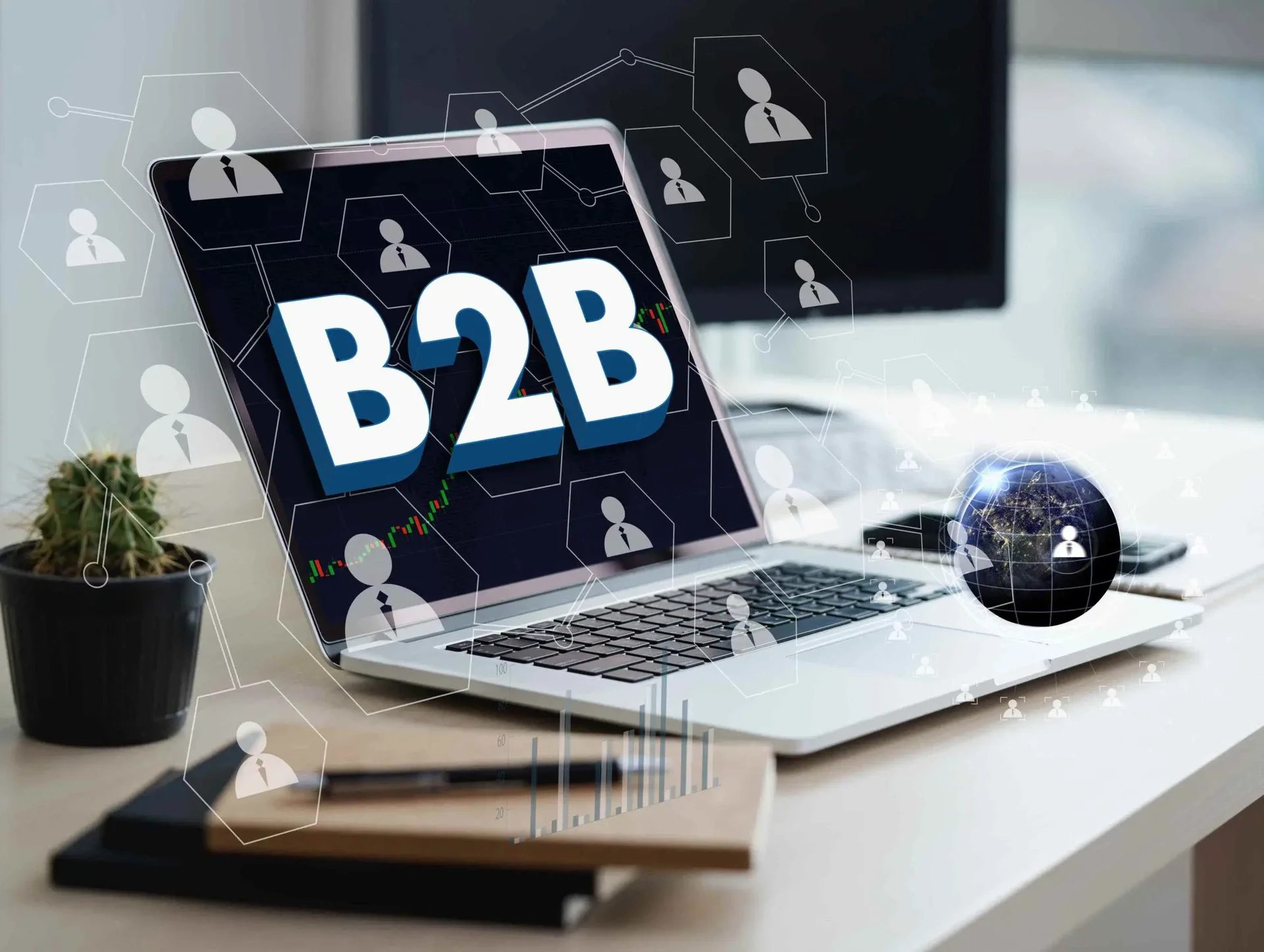In the world of digital marketing, having a functional, well-designed website is crucial for any business.
When it comes to Business-to-Business (B2B) companies, the design and user experience of their website become even more significant.
Understanding What Is B2B Website Design? can help businesses create a platform that not only looks professional but also effectively drives leads and conversions.
A B2B website is not just a digital brochure but an essential tool for generating leads, driving conversions, and establishing a company's digital presence.
A B2B website is fundamentally different from a Business-to-Consumer (B2C) website in its goals, target audience, and user behavior.
While B2C websites aim to engage individual customers and drive quick sales, B2B websites must cater to business decision-makers who often have longer, more complex buying processes.
These websites must emphasize credibility, provide valuable content, and facilitate lead generation through seamless navigation and strategically placed calls-to-action (CTAs).
This guide will delve into the key principles and components of B2B website design, explain the specific needs of B2B buyers, and showcase real-world examples to illustrate best practices.
What Is B2B Website Design?
B2B (Business-to-Business) website design refers to the process of creating and optimizing websites specifically for businesses that sell products or services to other businesses.
These websites are tailored to meet the needs of business buyers, offering detailed information, supporting complex decision-making processes, and providing a seamless experience for users navigating the site.
The underlying structure of such sites, often referred to as b2b website architecture, plays a key role in ensuring optimal functionality and user experience.
7 Key Features of B2B Website Design
Key features of B2B website design include a professional aesthetic, user-centric navigation, lead generation tools, content-rich product pages, mobile responsiveness, and SEO optimization to enhance user experience and drive business growth.
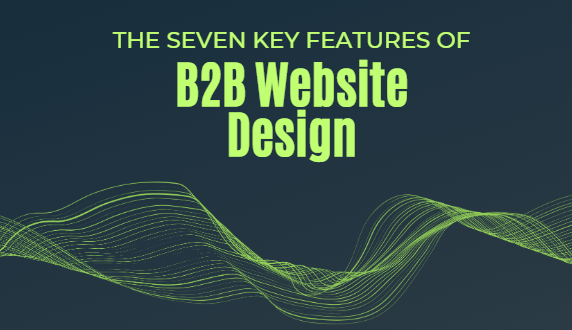
For instance, if you are in high ticket affiliate marketing, a professional-looking B2B website is crucial to ensure that prospective business clients trust your affiliate offers and engage with your content. Moreover, partnering with an enterprise SEO company can significantly enhance the visibility and effectiveness of your website, ensuring it ranks well in search engines, thus attracting more qualified business leads.
- Professional Aesthetic: A business-to-business website should look clean, professional, and trustworthy. The design should align with the company’s industry and brand identity to establish credibility.
- Lead Generation Focus: B2B websites typically prioritize lead generation over direct sales. This includes strategically placed forms, subscription options, or consultation booking tools to capture business inquiries and connect with decision-makers.
- Detailed Product Pages: Unlike B2C websites, B2B product pages tend to be more detailed, providing specifications, technical features, and use cases, as business buyers often need more information before making purchasing decisions.
- Content-Rich Resources: Business-to-business marketing websites often offer educational content such as white papers, case studies, blog posts, or webinars to attract and nurture leads.
- Clear Navigation: B2B websites need to be easy to navigate, with a focus on simplifying complex information for professionals who are often pressed for time. A well-organized structure allows users to quickly find the data they need.
- Responsive Design: A B2B website needs to be accessible across all devices, including mobile phones and tablets, as business professionals are increasingly using their mobile devices to make purchasing decisions.
- SEO Optimization: A business-to-business website needs to be optimized for search engines to ensure that the site appears when potential business customers search for relevant solutions.
Explore Our B2B Web Design & Development Services!
B2B Website Design vs. B2C Website Design
The fundamental difference between B2B vs B2C website design lies in the target audience, goals, and buying process. B2B websites focus on engaging business professionals, where content is detailed and the sales cycle is more complex, often based on what is network marketing strategies or long-term business partnerships. On the other hand, B2C websites aim to engage individual consumers with a quicker, more impulsive purchase cycle.
|
Aspect |
B2B Websites |
B2C Websites |
|
Target Audience |
Cater to businesses; content and design appeal to business professionals, decision-makers, and procurement officers. The goal is to establish credibility and showcase long-term value. |
Target individual consumers; aim to create an emotional connection or excitement around products or services. |
|
Sales Cycle |
Longer, more complex. Decisions are based on data, ROI, and long-term partnerships. The design focuses on providing ample information, facilitating contact with sales teams, and educating decision-makers. |
Shorter sales cycles are focused on immediate purchases. Flashy CTAs, promotional discounts, and a streamlined checkout process encourage spontaneous buying decisions. |
|
Content and Layout |
In-depth content such as technical specifications, case studies, white papers, and service descriptions to build trust over time. |
More visual, user-friendly layouts with product images designed to capture attention quickly. Content focuses on emotional appeal and convenience. |
|
Lead Generation |
Central focus on lead generation, with clear CTAs like "Request a Demo," "Get a Quote," or "Contact Sales" to engage with the sales team. |
Lead generation is important, but the primary focus is on immediate sales through impulse purchases, limited-time offers, and upsell tactics. |
|
Visual Appeal and Usability |
Functional and user-centric design, focusing on navigation and ease of access to information. Aesthetics are professional but not flashy. |
Prioritizes visual appeal, interactive elements, and user engagement to create a memorable experience for the consumer. |
How B2B Website Design Impacts Business-to-Business Marketing?
A strategically designed B2B website is crucial for the success of B2B marketing campaigns.
Here’s how an effective website contributes to business growth
1. Lead Generation and Conversion
With clear CTAs and optimized forms, a well-designed B2B website drives lead generation.
Thus, by offering valuable content (like industry reports or product demos), companies can capture essential contact information and nurture these leads into long-term business relationships. Moreover, what are five marketing strategies that retailers spend half of their annual budget on? Such strategies, including paid search and social media advertising, can also be integrated into your website to increase visibility and drive targeted traffic.
2. Brand Credibility and Trust
Business buyers are often more cautious than individual consumers, so trust is a significant factor in the B2B buying decision.
A professional, user-friendly website that showcases case studies, client testimonials, and certifications helps build credibility and strengthens brand trust.
For businesses offering b2b website development services, having a well-constructed site that instills confidence in potential clients is crucial for long-term success.
3. Improved Sales Cycle Efficiency
A B2B website designed with the buyer’s journey in mind can help move leads through the sales funnel faster.
By providing all the necessary information and resources, businesses can facilitate better-informed decision-making, shortening the sales cycle and increasing conversion rates.
4. Client Education
B2B web design often includes educational resources such as case studies, industry insights, and how-to guides.
These resources not only help establish authority but also assist prospective customers in understanding the value and benefits of your products or services.
5. Targeted Marketing and SEO
A B2B website optimized for search engines ensures that businesses rank for relevant keywords in their industry.
With proper SEO strategies, businesses can attract highly targeted traffic, ensuring that potential leads are more likely to convert.
Explore Our Digital Marketing Services!
7 Key Design Elements of the Best B2B Websites
When designing an effective B2B website, several key design elements must be taken into consideration to ensure the site is both functional and appealing to business clients.
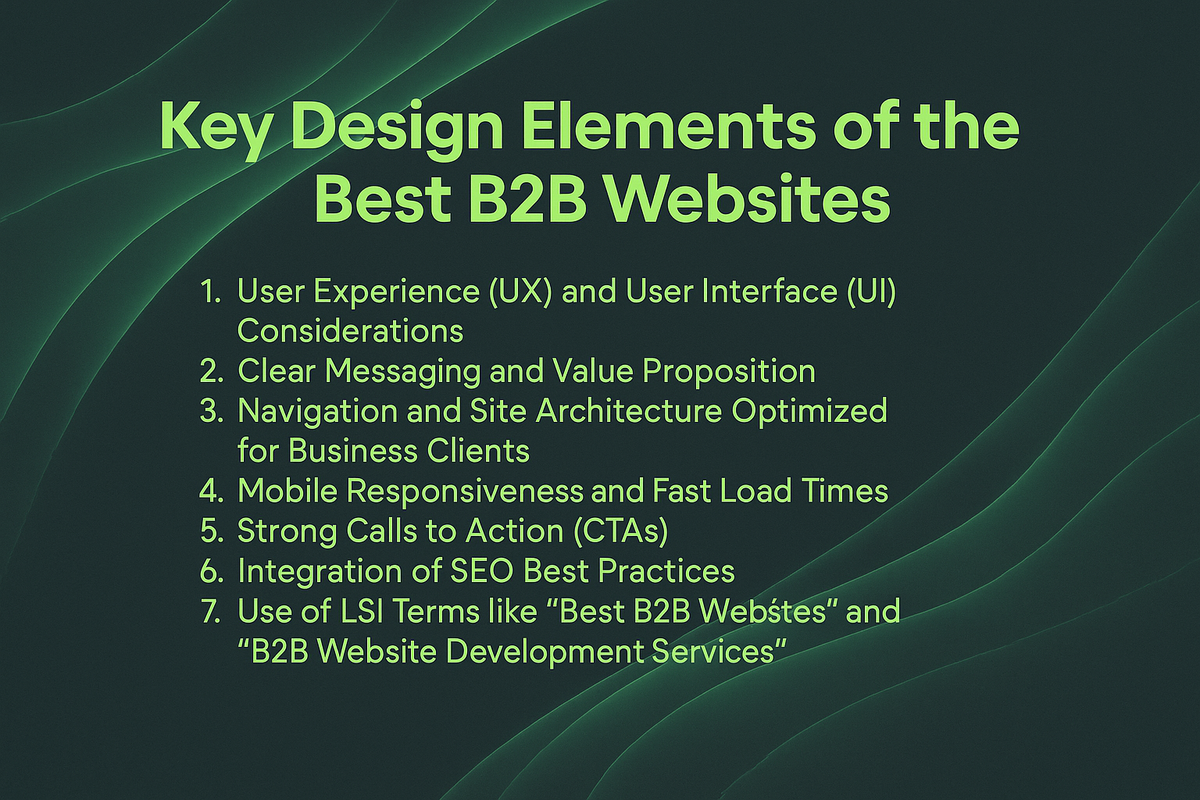
For example, if you’re wondering how to search for words on a page, adding a search bar with advanced filtering options can significantly improve usability for business professionals seeking specific content quickly.
These elements include a focus on user experience (UX), clear messaging, intuitive navigation, mobile responsiveness, strong calls to action (CTAs), and SEO best practices.
1. User Experience (UX) and User Interface (UI) Considerations
A seamless user experience is crucial for any B2B website. Users should be able to navigate the website without confusion and quickly find the information they need.
UX/UI design should ensure that the website feels intuitive and smooth, whether it's guiding potential clients through a product page or providing resources like case studies.
A clean, simple interface with easy-to-read fonts, a logical layout, and clear visuals can help enhance the user experience.
2. Clear Messaging and Value Proposition
The messaging on a B2B website should clearly communicate the business’s value proposition. Potential clients need to understand the benefits of working with your company and how your products or services can solve their specific business challenges.
The homepage and key landing pages should emphasize your unique selling points (USPs) and make it easy for users to grasp your offer in just a few seconds.
3. Navigation and Site Architecture Optimized for Business Clients
Business clients often seek detailed information, so a well-structured navigation system is key. Organizing content with a clear and logical site architecture, using categories such as
"Solutions," "Industries," "Resources," and "About Us," can improve usability and ensure that potential clients can find the relevant content quickly.
Easy-to-find filters, search bars, and drop-down menus can also enhance the user journey and guide them to exactly what they are looking for.
4. Mobile Responsiveness and Fast Load Times
With more business professionals accessing websites via mobile devices, a mobile-responsive design is a must for any B2B website.
Ensuring that your website functions smoothly across different screen sizes (smartphones, tablets, laptops) is critical.
Alongside mobile responsiveness, fast load times are essential, slow websites can result in high bounce rates and loss of potential leads.
Tools like Google PageSpeed Insights can help optimize load times for a better user experience.
5. Strong Calls to Action (CTAs)
A strong call to action (CTA) is essential for converting visitors into leads. For B2B websites, CTAs should be clear, compelling, and easy to find. Whether it’s "Request a Demo,"
"Get a Quote," or "Contact Us," CTAs must be placed strategically on key pages and throughout the user journey.
Multiple CTAs throughout the website (in the header, footer, and mid-content) can encourage engagement without overwhelming the user.
When focusing on aspects such as user experience, functionality, and conversion optimization, ecommerce site development plays a key role in ensuring that B2B websites are not only attractive but also highly effective in converting visitors into long-term clients.
6. Integration of SEO Best Practices
SEO is vital for any B2B website to be discoverable on search engines. By following SEO best practices such as keyword optimization, link-building, and technical SEO, your website can improve its visibility and ranking.
Integrating SEO-friendly URLs, optimized images, and relevant content will make it easier for business clients to find your website.
To enhance SEO for your B2B website, consider using an ecommerce SEO checklist to ensure that all aspects of SEO are covered.
7. Use of LSI Terms like “Best B2B Websites” and “B2B Website Development Services”
Incorporating Latent Semantic Indexing (LSI) keywords, like best B2B websites and B2B website development services, helps improve the website’s relevance in search engine rankings.
These LSI terms complement your main keywords and provide search engines with a better understanding of your website’s content, improving its visibility and discoverability for your target audience.
How Do I Create a Good B2B Website?
Creating a successful B2B website requires a structured approach, from planning to launch. Platforms like WordPress with WooCommerce are often used, as they provide a robust foundation.

A good digital marketing strategy that tracks users across the web is essential for remarketing and targeting visitors with personalized offers based on their behavior across your website.
Furthermore, investing in mobile web application development services ensures your site provides an optimized experience across all devices, which is crucial for businesses targeting decision-makers on-the-go.
Follow this step-by-step process to create a good B2B website:
- Planning: Define the website's goals, target audience, and functionality. Establish clear business objectives, such as lead generation or product showcasing, and highlight your value proposition.
- Wireframing: Create a blueprint of the website's layout, including navigation, content sections, and CTAs. Tools like Figma or Sketch can help ensure a user-friendly interface.
- Design: Focus on a professional, visually appealing design that aligns with your brand. Prioritize usability to make navigation intuitive.
- Development: Translate the design into a functional website using HTML, CSS, JavaScript, and backend technologies. Integrate necessary features like forms and product pages.
- Testing: Conduct functionality, usability, mobile responsiveness, SEO, and load testing to ensure the site works efficiently across devices and meets SEO standards.
- Launch: Finalize content, optimize speed, and set up tracking tools. Announce the launch via social media, email, and press releases.
Choosing the Right Platform and Tools
The platform and tools you select for your B2B website are key to its performance and scalability.
Popular options like WordPress (with WooCommerce), Shopify Plus, and Drupal offer flexibility and scalability, while more complex needs may require custom development with technologies like React, Angular, or Vue.js.
Consider scalability, customizability, security, and integration capabilities when choosing a platform to ensure it can grow with your business and meet your specific needs.
Importance of Content Strategy and SEO Optimization
A strong content strategy is crucial for clearly communicating your B2B website’s value proposition and building authority.
Your content should resonate with your target audience, offering solutions to business challenges.
SEO optimization ensures your website is discoverable by business clients, focusing on keyword research, on-page SEO, link building, and technical SEO. Implementing these practices enhances visibility, organic traffic, and user engagement.
Role of Professional Help: B2B Web Design Agency
While building a B2B website in-house is possible, hiring a B2B web design agency brings expertise, efficiency, and customization.
Agencies provide industry-specific knowledge and ensure your website is optimized for performance, user experience, and conversions.
Outsourcing design and development allows you to focus on core business functions while professionals handle your site’s creation and ongoing optimization.
Additionally, leveraging best digital brand strategy services can provide a comprehensive approach to establishing your online identity and increasing market visibility.
Linking Internally for Content Enhancement
To enhance content and increase user engagement, it’s essential to integrate relevant internal links within your website.
For instance, linking to articles like What Are Illustrations or Search for Words on a Web Page can provide additional resources to users, improving the time spent on your website and boosting SEO performance.
Six Ways to Upgrade Your B2B Website
Upgrading your B2B website is essential to stay relevant, functional, and effective. You can noindex pages that you don't want to rank on Google, like thank you pages or login pages, so they do not negatively impact your website’s SEO rankings. Here are key ways to enhance your site
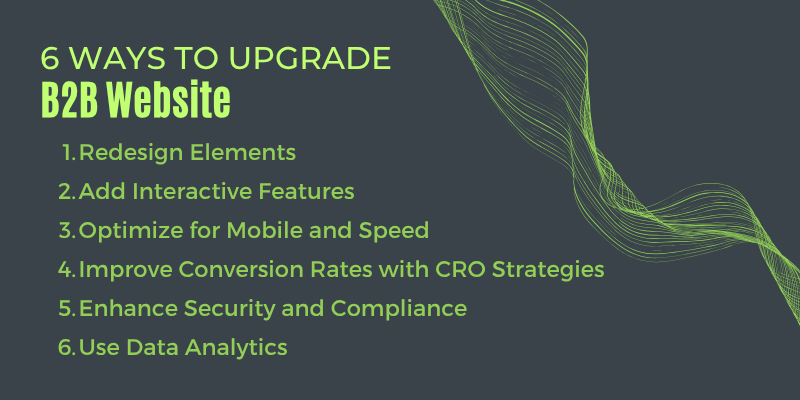
1. Redesign Elements
A clean, minimalistic design enhances navigation and usability, allowing users to easily find critical content.
Focus on user-centered design to reduce clicks and streamline the user journey. Responsive layouts ensure the website adapts seamlessly across all devices, providing a consistent experience on both desktop and mobile.
2. Add Interactive Features
Integrating chatbots provides real-time support and qualifies leads, enhancing user engagement.
Calculators allow users to assess costs, savings, or ROI, offering personalized value and improving decision-making.
3. Optimize for Mobile and Speed
Mobile optimization ensures the website provides a smooth experience on all devices.
Speed improvements, such as optimizing images and scripts, improve load times, which enhances user satisfaction and SEO rankings.
4. Improve Conversion Rates with CRO Strategies
Increase conversion rates by using clear CTAs, conducting A/B testing, and streamlining forms to reduce abandonment and guide users toward desired actions, such as signing up or contacting sales.
5. Enhance Security and Compliance
Ensure your website has SSL certificates for secure data transmission, complies with GDPR for data protection, and undergoes regular security audits to address potential vulnerabilities.
6. Use Data Analytics for Continuous Improvement
Use Google Analytics to track user behavior and identify areas for improvement. Refine content based on data insights to better meet user needs and improve overall website performance.
Explore Our B2B Marketing Services!
10 Best Examples of B2B Website Design
Here are 10 top examples of B2B websites that stand out for their exceptional design, user experience (UX), content strategy, and SEO.
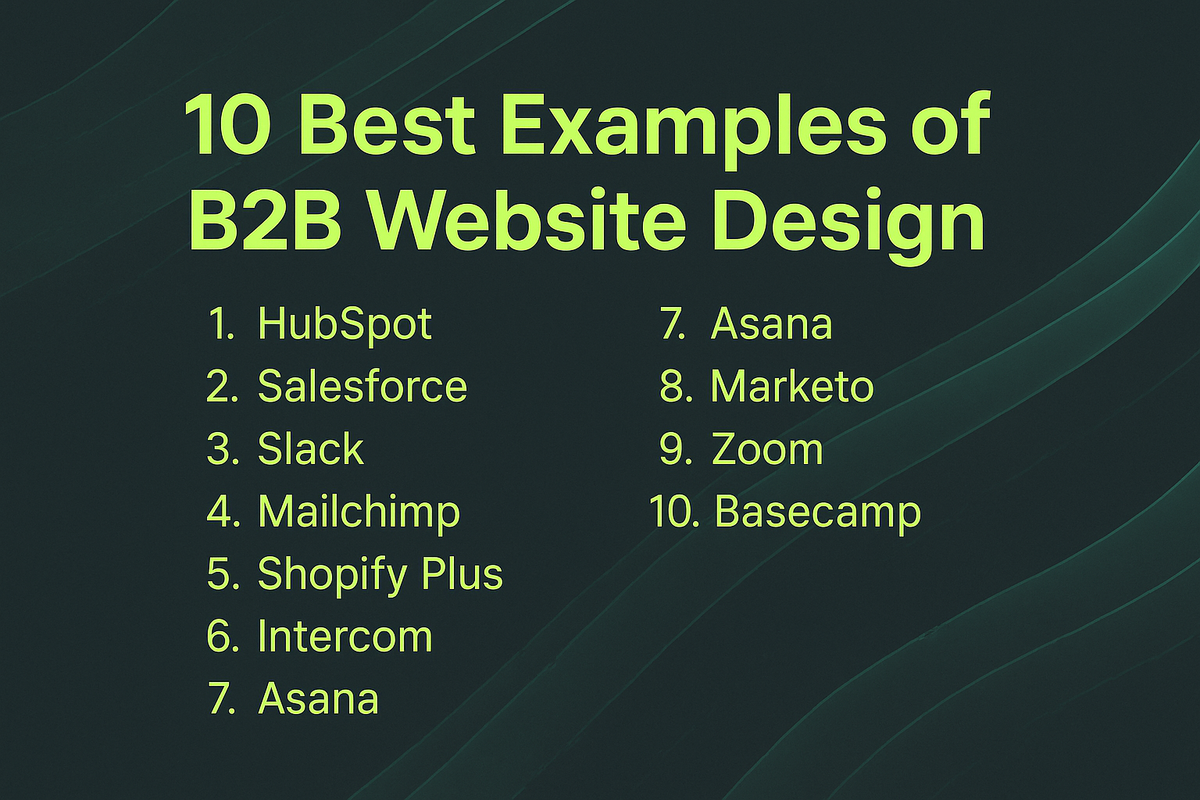
Each example offers valuable insights into what makes a business-to-business website successful.
These companies frequently employ advertisement examples and optimized CTAs to drive user engagement and conversion rates.
Each example offers valuable insights into what makes a business-to-business website successful.
1. HubSpot
HubSpot’s clean, minimal design emphasizes clarity and ease of navigation, with a focus on lead generation and educational content.
Its use of vibrant colors, clear CTAs, and strategically placed offers like eBooks and webinars guide users through the buying journey while its blog and resource center are optimized for SEO, attracting organic traffic.
The website also integrates eCommerce programmatic services, enabling personalized user experiences that drive conversions.
2. Salesforce
Salesforce features a sleek design with intuitive navigation, showcasing its CRM offerings with interactive elements.
The website is user-centric, offering personalized solutions based on business size and industry. The site is also optimized for SEO, with clear headings and relevant content, boosting visibility in search results.
3. Slack
Slack’s modern, clean website design offers easy navigation and clear CTAs, with a strong emphasis on its value proposition.
The minimal design reduces distractions, and interactive elements, like the product demo, engage visitors, making the site both informative and engaging.
4. Mailchimp
Mailchimp combines vibrant design with a user-friendly interface, utilizing illustrations and interactive content to keep visitors engaged.
The site is optimized for conversions with clear CTAs and an easy sign-up process, with tailored content for different business sizes and industries.
5. Shopify Plus
Shopify Plus features a clean design with bold images and conversion-focused CTAs. The site’s layout emphasizes simple navigation and communicates the platform's offerings clearly, providing a seamless user experience with fast load times and compelling messaging.
6. Intercom
Intercom’s minimalist design with soft colors creates a welcoming feel. The site focuses on clear messaging and well-placed CTAs to promote its customer support solutions.
Its straightforward content answers visitor questions directly, making it easy to navigate and understand.
7. Asana
Asana’s modern, user-centric design highlights its core benefits with intuitive navigation and well-placed content.
The website offers interactive product tours and easy access to the blog, keeping visitors engaged and informed about the platform’s features.
8. Marketo
Marketo’s professional design features a corporate feel, focusing on performance with engaging visuals and direct messaging.
The website guides users to book demos through effective CTAs and is optimized for SEO to address customer needs at various stages of the buying cycle.
9. Zoom
Zoom’s straightforward design emphasizes functionality, with minimal distractions. The website loads quickly and has clear CTAs to get users started.
It communicates the product's value effectively, offering easy access to sign-up forms and customer support.
10. Basecamp
Basecamp’s clean design focuses on usability, with bold headlines and visuals that make the site engaging without overwhelming visitors.
The concise messaging and clear CTAs guide users to sign up or learn more, ensuring a simplified user journey.
FAQs: What Is B2B Website Design?
How much does a B2B website cost?
The cost of a B2B website typically ranges from $3,000 to $10,000, depending on complexity and features like high-level SEO strategies or even tools like the best SEO tools for small businesses, costs could vary further.
What should a B2B website have?
A B2B website should have clear messaging, intuitive navigation, lead generation tools, responsive design, and SEO optimization. Additionally, it should be equipped with educational content, such as what is illustration in your industry, to add value to business clients.
Which website platform is best for B2B business?
Platforms like Shopify Plus, WordPress with WooCommerce, and Drupal are popular for B2B websites due to their scalability and flexibility, offering Google Ads cost analysis features for business owners managing ad budgets.
How much would a small business pay for a website?
Small businesses typically pay between $1,000 and $5,000 for a basic website, depending on features and design complexity.
Conclusion
An effective B2B website design is crucial for businesses looking to establish credibility, attract quality leads, and drive long-term growth. A well-designed website is not only a professional representation of your business but also an essential tool for lead generation, user engagement, and seamless navigation. Understanding What Is B2B Website Design? can help ensure that your website is tailored to meet the specific needs of business clients, optimizing both form and function. Key elements such as clear messaging, mobile responsiveness, and optimized user experience (UX) are fundamental in making a lasting impact on potential business clients. The development of a B2B website is an ongoing process.
By continuously refining your website’s content, design, and performance based on user feedback and data analytics, you ensure it remains relevant and effective in meeting business goals. Optimization, especially through SEO and Digital Marketing services, is key to driving organic traffic and increasing visibility for your business. If you’re ready to take your business-to-business website to the next level, explore our SEO Services, Digital Marketing services, and Digital Transformation Services. Whether you're looking to redesign an existing website or build one from scratch, contacting a professional B2B website design and development company can help you launch a site that meets your business needs and stands out in a competitive market. Whether you're looking to redesign an existing website or build one from scratch, contacting a professional B2B website design and development company like Centric can help you launch a site that meets your business needs and stands out in a competitive market.
